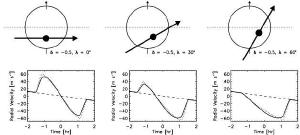Blog
Tilt Shift
4 November 2013
 Gaudi, B. Scott, and Joshua N. Winn
Gaudi, B. Scott, and Joshua N. WinnThe color of light we observe from a star depends not only on the color emitted from the star, but also the speed of that star relative to us. From this simple fact we can actually determine a great deal about a star, including the star’s axis of rotation relative to orbiting planets.
Stars don’t emit a continuous range of colors, but rather a spectrum of colors with gaps known as absorption lines. These absorption lines are due to the cooler (cooler being a relative term) outer layer of the star absorbing some of the light from the hotter interior. The wavelengths of light absorbed are dependent on the types of elements that exist in the outer layer. Each element has a unique pattern of absorption lines, like an atomic fingerprint.
Since the absorption lines for a particular element are unique, we can compare the absorption lines in a star with the absorption lines we observe in labs here on Earth. If the star were stationary relative to us, then the starlight and lab patterns would be identical. But usually that isn’t the case, so there are differences between them.
One of these differences is when the starlight pattern is shifted in wavelength. If the pattern is shifted toward shorter (bluer) wavelengths, then it is said to be blueshifted. If it is shifted toward longer (redder) wavelengths, it is said to be redshifted. This blueshift or redshift of the light is due to the relative motion of the star, and is known as the Doppler effect. You’re likely familiar with the Doppler effect for sound. When a car or train passes you, the sound from it shifts from higher to lower. That’s because when an object moves toward you the sound waves are bunched up a bit, making the wavelength shorter. When an object moves away from you the sound waves are stretched a bit, making the wavelengths longer. The same is true for light, so when starlight is blueshifted it means the star is moving toward us. When the star is moving away from us, the light is redshifted.
Of course most stars also rotate, and that leads to a different effect. When a star rotates, one side of the star is rotating toward us, while the other side is rotating away from us. This means that if you look at light from one side of the star it will be slightly blueshifted from the average light of the star, and when you look at the other side it will be slightly redshifted. Most stars are so distant that we can’t simply look at one part or another. As a result, we see the rotation of the star as a broadening of the absorption lines. The lines are shifted overall due to the motion of the star relative to us, and they are broadened due to the rotation.
The broadening of the lines tells us only part of the story about a star’s rotation. The broadening depends on the speed of rotation, so the greater the rotation the more broadening we observe. But it only depends on the rotational speed relative to us. If we happen to view a star along its equator, then we will see a great deal of broadening, however if we view it along its polar axis we won’t see any broadening at all. So a small amount of line broadening could be evidence of a slow rotating star, or it could be a fast rotating star that we view near its pole.
But if a star has a planet that crosses in front of the star from our point of view, then we can determine the tilt of the star. To see how this works, imagine a star rotating so the left side rotates toward us and the right side away from us. If a planet passes in front of the star from left to right, it will first block light from the left side of the star, meaning we will see more light from the right side. Thus we will observe more redshift than blueshift. As the planet passes to the right side of the star we will see more blueshift than redshift.
That change in the Doppler shift of the light during the planet’s crossing is known as the Rossiter-McLaughlin effect, and you can see it in the image above. By observing the specific change in Doppler shift, we can determine the tilt of the star relative to the orbit of the planet. Knowing that, we can determine the precise rotation of the star as well.
By carefully observing starlight we can not only learn about the planets orbiting a star, we can learn more about the star itself.